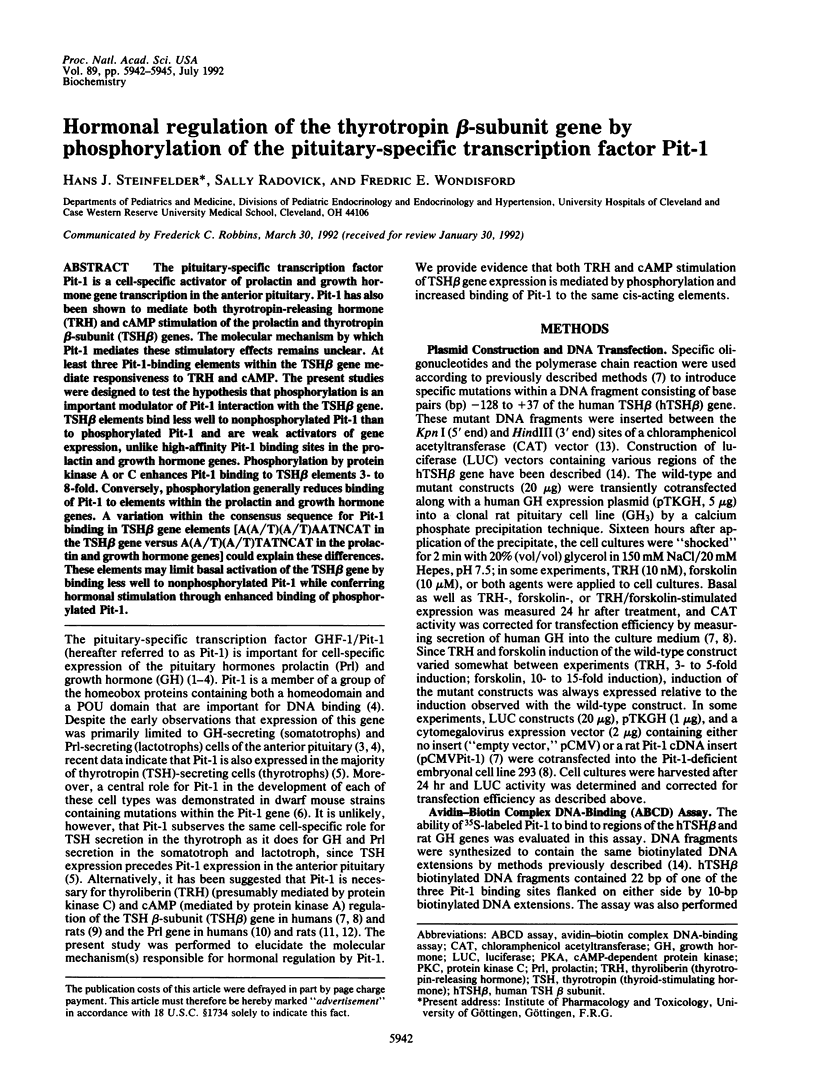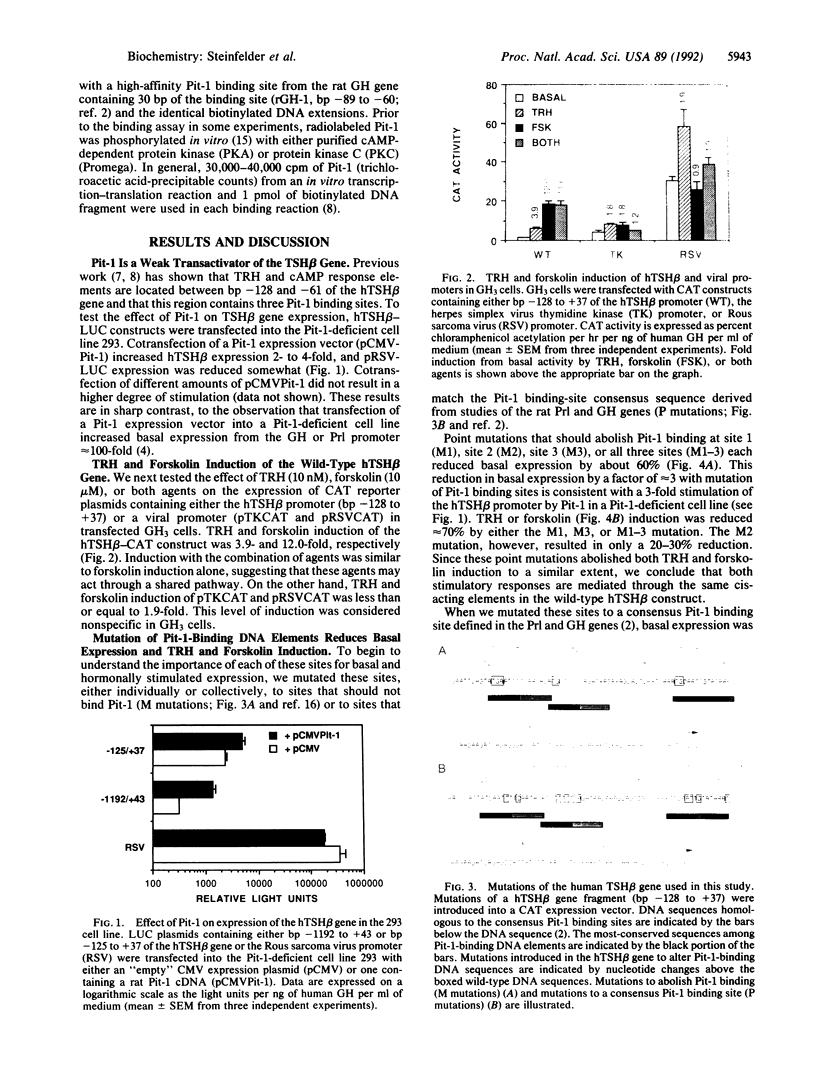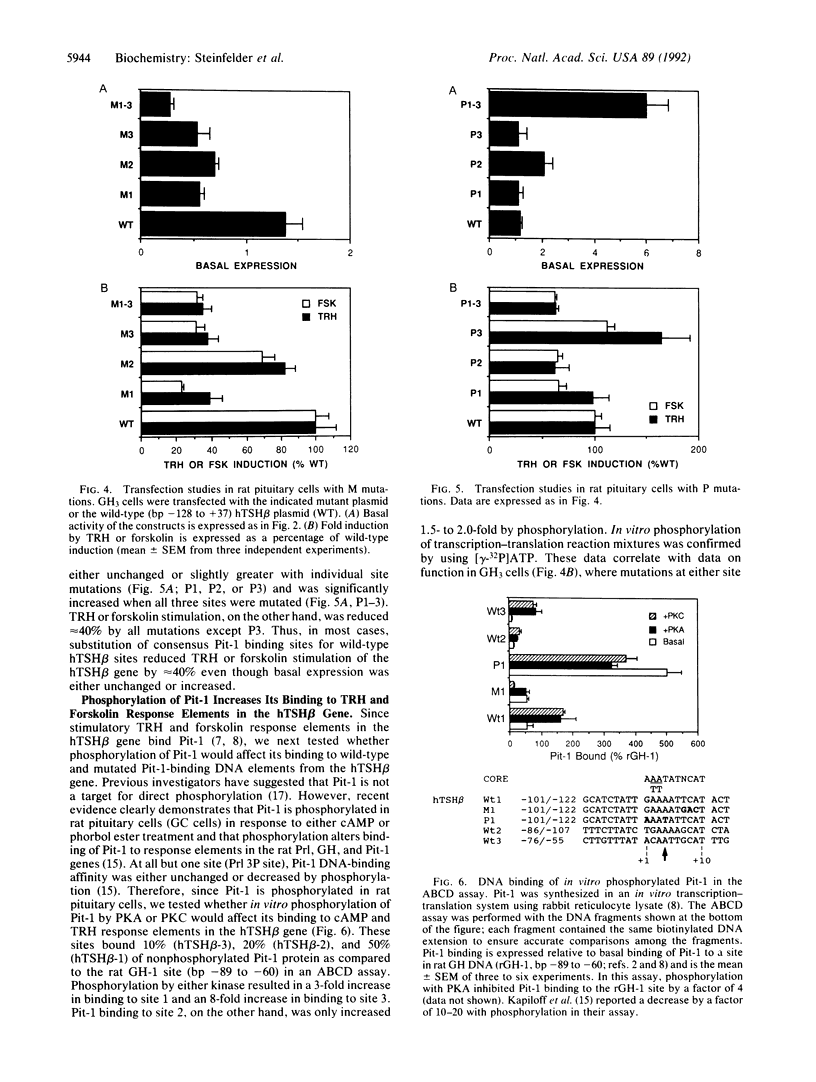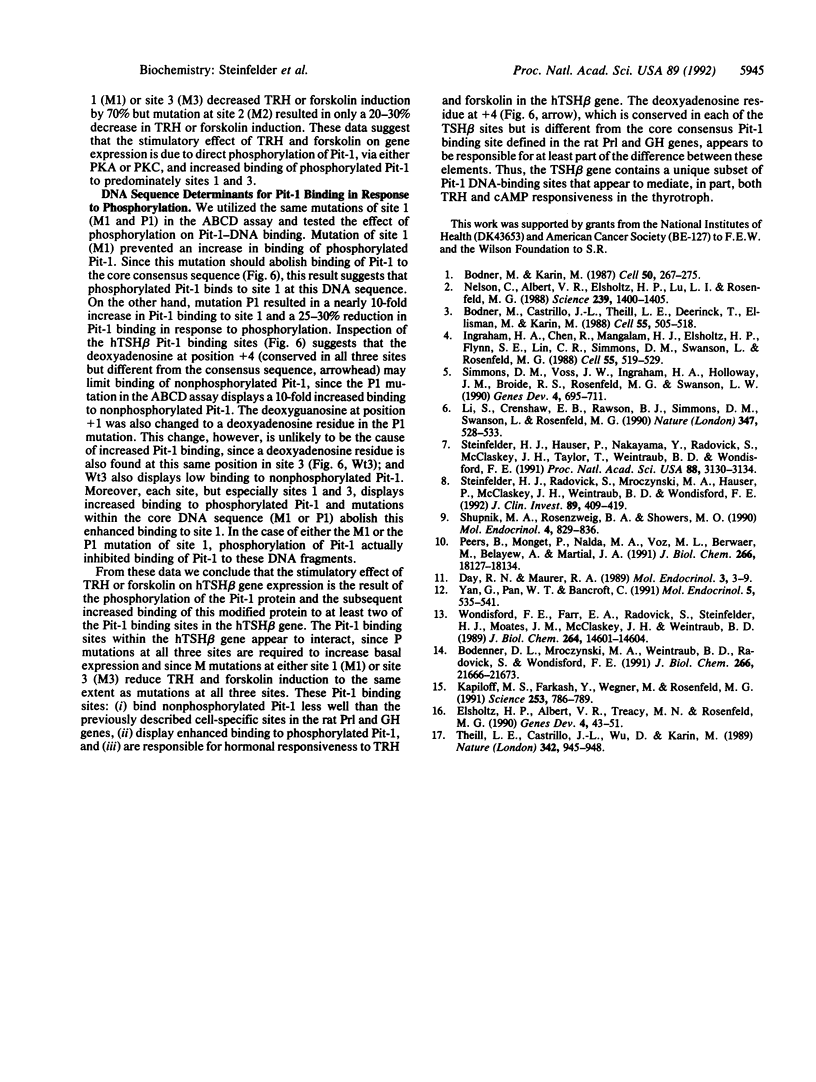Abstract
The pituitary-specific transcription factor Pit-1 is a cell-specific activator of prolactin and growth hormone gene transcription in the anterior pituitary. Pit-1 has also been shown to mediate both thyrotropin-releasing hormone (TRH) and cAMP stimulation of the prolactin and thyrotropin beta-subunit (TSH beta) genes. The molecular mechanism by which Pit-1 mediates these stimulatory effects remains unclear. At least three Pit-1-binding elements within the TSH beta gene mediate responsiveness to TRH and cAMP. The present studies were designed to test the hypothesis that phosphorylation is an important modulator of Pit-1 interaction with the TSH beta gene. TSH beta elements bind less well to nonphosphorylated Pit-1 than to phosphorylated Pit-1 and are weak activators of gene expression, unlike high-affinity Pit-1 binding sites in the prolactin and growth hormone genes. Phosphorylation by protein kinase A or C enhances Pit-1 binding to TSH beta elements 3- to 8-fold. Conversely, phosphorylation generally reduces binding of Pit-1 to elements within the prolactin and growth hormone genes. A variation within the consensus sequence for Pit-1 binding in TSH beta gene elements [A(A/T)(A/T)AATNCAT in the TSH beta gene versus A(A/T)(A/T)TATNCAT in the prolactin and growth hormone genes] could explain these differences. These elements may limit basal activation of the TSH beta gene by binding less well to nonphosphorylated Pit-1 while conferring hormonal stimulation through enhanced binding of phosphorylated Pit-1.
Full text
PDF



Images in this article
Selected References
These references are in PubMed. This may not be the complete list of references from this article.
- Bodenner D. L., Mroczynski M. A., Weintraub B. D., Radovick S., Wondisford F. E. A detailed functional and structural analysis of a major thyroid hormone inhibitory element in the human thyrotropin beta-subunit gene. J Biol Chem. 1991 Nov 15;266(32):21666–21673. [PubMed] [Google Scholar]
- Bodner M., Castrillo J. L., Theill L. E., Deerinck T., Ellisman M., Karin M. The pituitary-specific transcription factor GHF-1 is a homeobox-containing protein. Cell. 1988 Nov 4;55(3):505–518. doi: 10.1016/0092-8674(88)90037-2. [DOI] [PubMed] [Google Scholar]
- Bodner M., Karin M. A pituitary-specific trans-acting factor can stimulate transcription from the growth hormone promoter in extracts of nonexpressing cells. Cell. 1987 Jul 17;50(2):267–275. doi: 10.1016/0092-8674(87)90222-4. [DOI] [PubMed] [Google Scholar]
- Day R. N., Maurer R. A. The distal enhancer region of the rat prolactin gene contains elements conferring response to multiple hormones. Mol Endocrinol. 1989 Jan;3(1):3–9. doi: 10.1210/mend-3-1-3. [DOI] [PubMed] [Google Scholar]
- Elsholtz H. P., Albert V. R., Treacy M. N., Rosenfeld M. G. A two-base change in a POU factor-binding site switches pituitary-specific to lymphoid-specific gene expression. Genes Dev. 1990 Jan;4(1):43–51. doi: 10.1101/gad.4.1.43. [DOI] [PubMed] [Google Scholar]
- Ingraham H. A., Chen R. P., Mangalam H. J., Elsholtz H. P., Flynn S. E., Lin C. R., Simmons D. M., Swanson L., Rosenfeld M. G. A tissue-specific transcription factor containing a homeodomain specifies a pituitary phenotype. Cell. 1988 Nov 4;55(3):519–529. doi: 10.1016/0092-8674(88)90038-4. [DOI] [PubMed] [Google Scholar]
- Kapiloff M. S., Farkash Y., Wegner M., Rosenfeld M. G. Variable effects of phosphorylation of Pit-1 dictated by the DNA response elements. Science. 1991 Aug 16;253(5021):786–789. doi: 10.1126/science.1652153. [DOI] [PubMed] [Google Scholar]
- Li S., Crenshaw E. B., 3rd, Rawson E. J., Simmons D. M., Swanson L. W., Rosenfeld M. G. Dwarf locus mutants lacking three pituitary cell types result from mutations in the POU-domain gene pit-1. Nature. 1990 Oct 11;347(6293):528–533. doi: 10.1038/347528a0. [DOI] [PubMed] [Google Scholar]
- Nelson C., Albert V. R., Elsholtz H. P., Lu L. I., Rosenfeld M. G. Activation of cell-specific expression of rat growth hormone and prolactin genes by a common transcription factor. Science. 1988 Mar 18;239(4846):1400–1405. doi: 10.1126/science.2831625. [DOI] [PubMed] [Google Scholar]
- Peers B., Monget P., Nalda M. A., Voz M. L., Berwaer M., Belayew A., Martial J. A. Transcriptional induction of the human prolactin gene by cAMP requires two cis-acting elements and at least the pituitary-specific factor Pit-1. J Biol Chem. 1991 Sep 25;266(27):18127–18134. [PubMed] [Google Scholar]
- Shupnik M. A., Rosenzweig B. A., Showers M. O. Interactions of thyrotropin-releasing hormone, phorbol ester, and forskolin-sensitive regions of the rat thyrotropin-beta gene. Mol Endocrinol. 1990 Jun;4(6):829–836. doi: 10.1210/mend-4-6-829. [DOI] [PubMed] [Google Scholar]
- Simmons D. M., Voss J. W., Ingraham H. A., Holloway J. M., Broide R. S., Rosenfeld M. G., Swanson L. W. Pituitary cell phenotypes involve cell-specific Pit-1 mRNA translation and synergistic interactions with other classes of transcription factors. Genes Dev. 1990 May;4(5):695–711. doi: 10.1101/gad.4.5.695. [DOI] [PubMed] [Google Scholar]
- Steinfelder H. J., Hauser P., Nakayama Y., Radovick S., McClaskey J. H., Taylor T., Weintraub B. D., Wondisford F. E. Thyrotropin-releasing hormone regulation of human TSHB expression: role of a pituitary-specific transcription factor (Pit-1/GHF-1) and potential interaction with a thyroid hormone-inhibitory element. Proc Natl Acad Sci U S A. 1991 Apr 15;88(8):3130–3134. doi: 10.1073/pnas.88.8.3130. [DOI] [PMC free article] [PubMed] [Google Scholar]
- Steinfelder H. J., Radovick S., Mroczynski M. A., Hauser P., McClaskey J. H., Weintraub B. D., Wondisford F. E. Role of a pituitary-specific transcription factor (pit-1/GHF-1) or a closely related protein in cAMP regulation of human thyrotropin-beta subunit gene expression. J Clin Invest. 1992 Feb;89(2):409–419. doi: 10.1172/JCI115600. [DOI] [PMC free article] [PubMed] [Google Scholar]
- Theill L. E., Castrillo J. L., Wu D., Karin M. Dissection of functional domains of the pituitary-specific transcription factor GHF-1. Nature. 1989 Dec 21;342(6252):945–948. doi: 10.1038/342945a0. [DOI] [PubMed] [Google Scholar]
- Wondisford F. E., Farr E. A., Radovick S., Steinfelder H. J., Moates J. M., McClaskey J. H., Weintraub B. D. Thyroid hormone inhibition of human thyrotropin beta-subunit gene expression is mediated by a cis-acting element located in the first exon. J Biol Chem. 1989 Sep 5;264(25):14601–14604. [PubMed] [Google Scholar]
- Yan G. Z., Pan W. T., Bancroft C. Thyrotropin-releasing hormone action on the prolactin promoter is mediated by the POU protein pit-1. Mol Endocrinol. 1991 Apr;5(4):535–541. doi: 10.1210/mend-5-4-535. [DOI] [PubMed] [Google Scholar]




